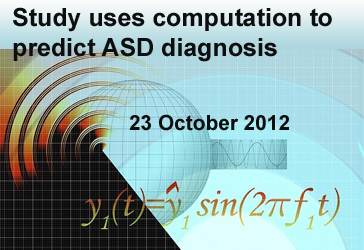Check out other stories from the Latest News
Computational Method May Aid Autism Diagnosis
By Chelsea E. Toledo, M.A. on October 23, 2012

Background: Recent technological advances have the potential to improve how Autism Spectrum Disorders (ASD) are classified and diagnosed. Brain cells use energy when they communicate with each other, which results in increased blood flow to their local area to replenish their energy. Scientists use a technique called functional magnetic resonance imaging (fMRI) to measure these changes in blood flow, allowing them to infer which areas of the brain are active.. Computational approaches are then used to help find patterns of activated brain regions, allowing ASD patient brain activity patterns to be compared to those of neurotypical patients.
What’s new: In a study published in the October 2012 edition of the online journal PLoS ONE, researchers detail an emerging computational approach for analyzing fMRI data from 58 people—half of whom had an ASD diagnosis. They monitored the activity of 106 brain regions and found their method could distinguish ASD patients in >80% of the cases. Additionally, the researchers found that an ASD diagnosis could better be predicted at a fine scale rather than at a coarse scale (involving long-range connections between different brain regions) that researchers typically look at.
Why it’s important: Many scientists believe that ASD is associated with the way regions of the brain interact with one another, but few have been able to demonstrate concretely how those problems manifest. Better ways of analyzing brain images could lead to a better understanding of how ASD works—and how it can be remedied.
Help me understand :
| Source(s) : |
| Tweet |

